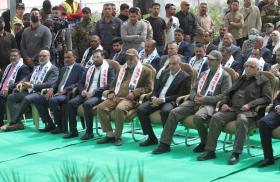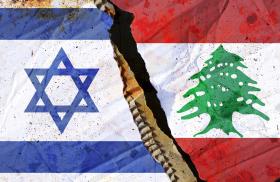
Profile: Badr Organization

Part of a series: Militia Spotlight: Profiles
or see Part 1: How to Use Militia Spotlight: Profiles
Badr is the wellspring of many of today's armed resistance groups and still operates under the indirect and sometimes direct control of Iran's Islamic Revolutionary Guard Corps.
Name: Munadhamat Badr (Badr Organization)
Type of Movement
Political, armed (fasail), and social group. Full spectrum of kinetic military operations, information operations (media activities and propaganda), and social operations. Information operations against U.S. and Iraqi government. Logistical support to kinetic military operations against same. Domestic counter-moderate (protestor) operations and counter-U.S. operations.
History and Objectives
- Formed by Iran’s Islamic Revolutionary Guard Corps (IRGC) in 1982-83.
- Originally called Failaq Badr (Badr Brigades), founded by the IRGC as the armed wing of its Supreme Council for Islamic Revolution in Iraq (SCIRI, later Islamic Supreme Council of Iraq, or ISCI), drawing on Iranian-held Iraqi Shia prisoners of war (ahrar) and anti-Saddam oppositionists (mujahedin).
- Senior commanders in Badr included Abu Mahdi al-Muhandis, Hadi al-Ameri, Abu Mustafa al-Sheibani, and Abu Muntadher al-Husseini.
- Fought twenty-year war against the Baathist regime using guerrilla and terrorist tactics. Badr member Muhandis was accused of international terrorist attacks and later sentenced to death in absentia by Kuwait.
- Renamed Munadhamat Badr (Badr Organization of Reconstruction and Development) in 2004. Split from ISCI in 2012 to compete in Iraqi elections.
- As of October 2021, Badr is the largest party (9 seats) in the 20-seat Tahalof al-Fatah (Conquest Alliance).
- Integrated many Badr members into the Iraqi security forces and, after 2014, into the Popular Mobilization Forces (PMF). Badr member Qasim al-Araji is Iraq's national security advisor and a former interior minister.
- Badr also sent groups of fighters to Syria to bolster the Assad regime, as part of Badr al-Janah al-Askari fi Suriya (Badr Military Wing in Syria), also known as Quwat al-Shahid Muhammad Baqir al-Sadr (Forces of the Martyr Muhammad Baqir al-Sadr).
Chain of Command
Badr is a large and complex organization with military and political wings and many sub-factions. Broadly, it has become deeply embedded in the Iraqi state through its electoral successes, paramilitary power, and patronage networks. Badr was the wellspring for many younger—and more radical—fasail factions, including Kataib Hezbollah (KH). Elements of the organization maintain a prominent role in the muqawama (resistance). Meanwhile, Badr remains true to its roots as an Iranian proxy and continues to enjoy close institutional and interpersonal relations with the IRGC.
Partly financed by the Iraqi state. Badr operates at least ten brigades of the state-funded PMF, and possibly as many as seventeen. As a matter of Iraqi law, PMF brigades are Iraqi state organs. Badr military forces within the Defense Ministry, Interior Ministry, PMF, and other units are legally obliged to follow legal orders from Iraq’s prime minister (i.e., the commander-in-chief). Badr’s PMF brigades sometimes disobey the government chain of command while legally remaining organs of the state, for instance refusing the prime minister's order to take part in the Battle of Tikrit if coalition airpower supported the operation.
Direct and indirect Iranian influence and control. Badr is a walai movement, meaning that if called upon, it will recognize Iran’s Supreme Leader as a higher authority than Iraq’s prime minister. As a young commander fighting on Iran’s side, Hadi al-Ameri is on record as stating, “We are with the Imam [Khomeini]...If our Imam says war then we say its war, if Imam says peace then its peace...Now we know the Imam represents Islam.” The Badr military wing in Syria is directly commanded by the IRGC.
U.S. federal courts have found that Iran provides material support for the Badr Organization and that Iran has directly sponsored Badr's activities in Iraq, including intelligence gathering and acts of sabotage and subversion in Shia-majority southern Iraq (e.g., see W.A. v. Islamic Republic of Iran, 427 F. Supp. 3d. 117, 125-127, & 134, U.S. District Court for the District of Columbia, 2019).
Internal leadership. Badr has a secretary-general (Ameri) and a shura council that comprises Ameri, Araji, and Husseini, along with Mohammed al-Ghabban and Abu Ali al-Basri.
Affiliate Relationships
PMF: Badr is affiliated with most PMF member units/organizations and can be counted on to give them mutual support if they are threatened.
Muqawama: Badr is a component of al-Muqawama al-Islamiyah (the Islamic Resistance) in Iraq and seeks the complete withdrawal of U.S. forces from the region. Badr iconography mirrors broader patterns and themes within the muqawama. In recent years, Badr has adopted a less overt position within the wider muqawama. Groups such as KH, Asaib Ahl al-Haq, and Harakat al-Nujaba are relatively open about their efforts to attack U.S. and allied targets; by contrast, Badr distances itself publicly from such actions. Nevertheless, muqawama media channels frequently place Badr and its leadership in the same categories and references as more openly radical fasail.
In 2019, Tasnim (an IRGC-affiliated news agency) reported on the Iraqi muqawama response to the United States designating the IRGC as a foreign terrorist organization under the title “The Iraqi muqawama fasail denounce the designation of the IRGC as an FTO.” The only Iraqi statement in the article came from Abu Farqad al-Sadawi, the head of Badr’s office in Najaf, suggesting the IRGC’s news agency understands Badr to be a part of (and able to speak for) the wider muqawama.
Badr has not publicly claimed that it is part of the Tansiqiya (muqawama coordinating committee), but resistance media frequently refer to Badr alongside other core muqawama fasail. The Tansiqiya provides loose coordination for muqawama activities, as well as a point of contact for coordination between militia leadership and the IRGC. Badr’s size, prominence, and standing within the muqawama mean that it likely has representation on the committee, and some reporting indicates that Badr secretary Ameri became the elder leader within the Tansiqiya in June 2021.
IRGC: Badr is a member of the "axis of resistance" led by the IRGC. It has enjoyed a close relationship with the IRGC since its founding.
KH and KSS: Many former Badr members are senior officials in the U.S.-designated terrorist groups KH and Kataib Sayyid al-Shuhada (KSS). Examples have included Muhandis (now deceased), Abu Fadak al-Muhammadawi (the current operational head of the PMF and a senior KH commander), and KSS founder Sheibani.
Subordinate Elements
- Badr military wing in Iraq (al-Janah al-Askari li Munadhamat Badr). The group controls the state-funded 1st, 4th, 5th, 9th, 10th, 21st, 22nd, 23rd, 24th, and 27th Brigades of the PMF, and appears to have strong influence over the 16th, 30th, 36th, 50th, 52nd, 53rd, 55th, and 110th Brigades.
- Badr military wing in Syria.
- Qanat al-Ghadeer television channel.
- Official website domain (http://badr.iq/) is currently inactive
- Official global news website Wakalat Badr al-Akhbariya.
- Official Telegram channel Manasat Baa (“B Platform”), launched in June 2021. Its use of the letter “Baa” (for Badr) may have been inspired by Kataib Hezbollah’s “Kaf” (K) media channels. Manasat Baa also runs Facebook, YouTube, Instagram, and TikTok accounts. Its Facebook page reads, “An electronic platform interested in all the activities of Badr, the Fasail, and the Muqawama al-Islamiyya in Iraq.” Its Telegram bio reads, “An electronic platform interested in all the activities of Badr and the Islamic Muqawama in Iraq.” Each of these platforms has tens of thousands of followers.
- Dozens of additional social media accounts on Facebook, YouTube, Instagram, and Twitter, many of which are administered by and affiliated with Badr’s media center (al-Markaz al-Iami li Munadhamat Badr) and office branches in various Iraqi cities.
- The Badr Islamic Cultural Center (Markaz Badr al-Thaqafi al-Islami). This organization includes a dedicated local television channel.
- Wilaya Youth Gathering (Tajamma Shabab al-Wilaya), Badr’s youth organization.









